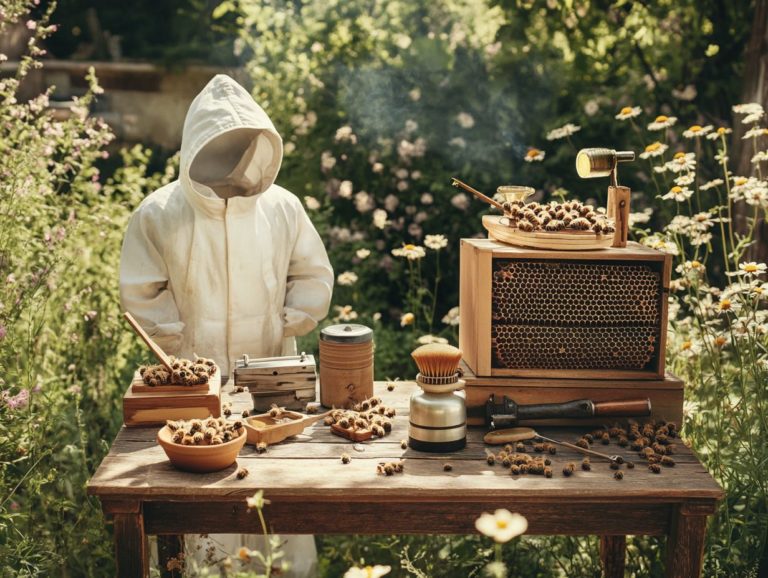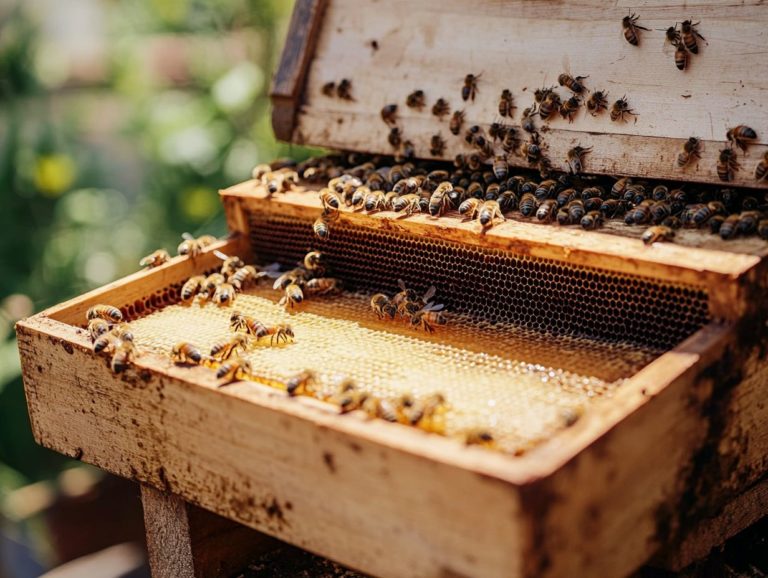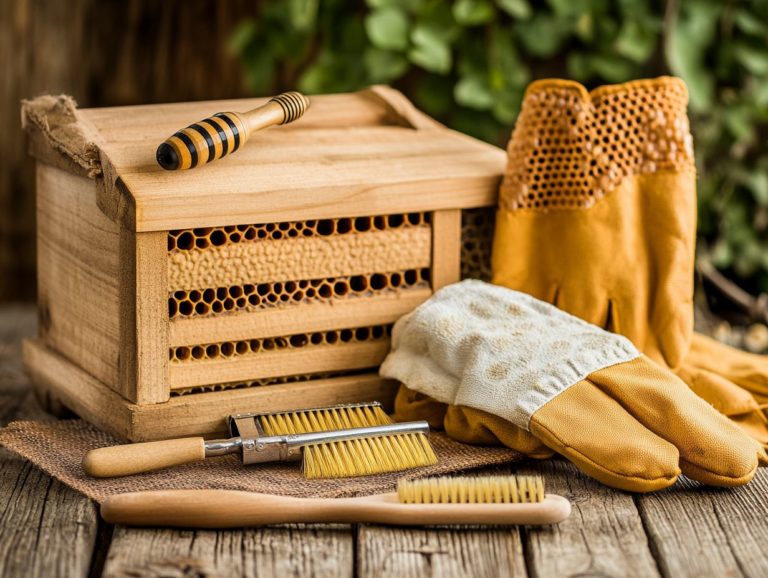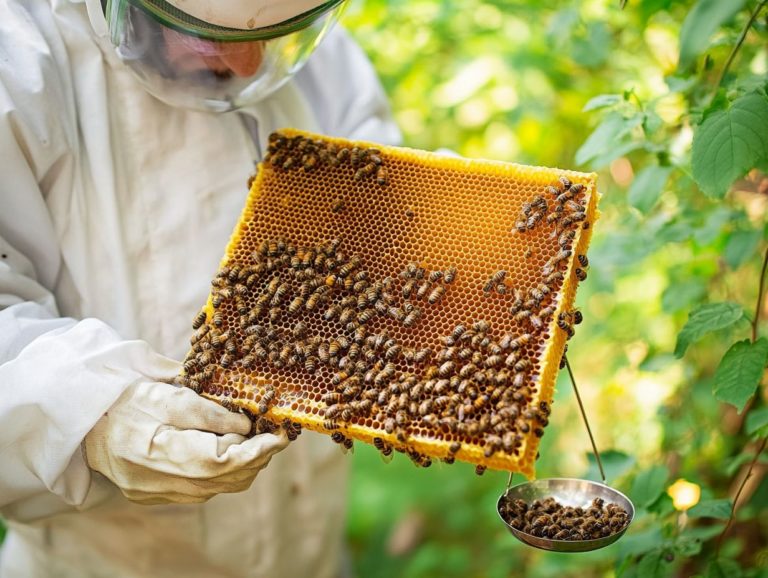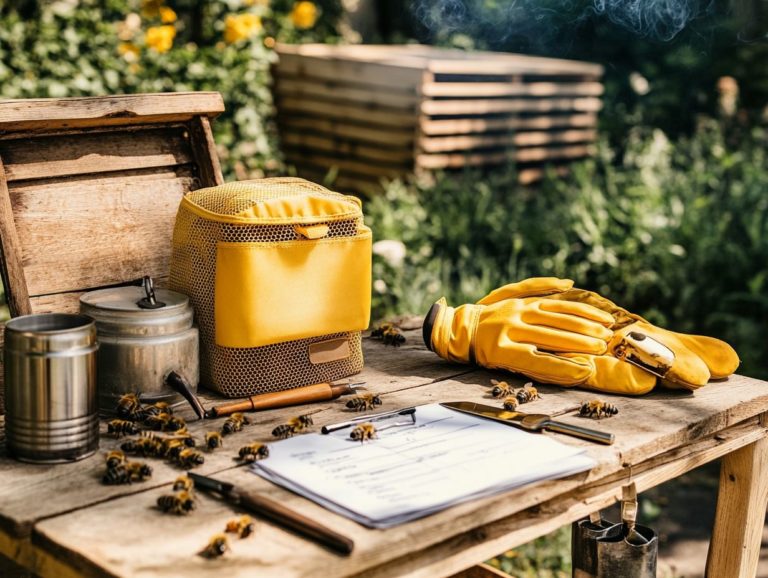How to Organize Your Beekeeping Supplies
Beekeeping is a rewarding endeavor, but you’ll need the right tools and supplies to ensure your success. This article outlines the essential beekeeping gear you ll require, from protective clothing to specialized beekeeping equipment like smokers and honey extractors.
You’ll find practical tips for organizing your supplies, making it easy to locate everything when the time comes. You will also find guidance on maintaining and replacing your tools, including hive parts, to keep your beekeeping journey running smoothly and efficiently.
Prepare to dive into the fascinating world of beekeeping!
Contents
- Key Takeaways:
- Must-Have Beekeeping Supplies for Success
- Additional Beekeeping Supplies
- How to Organize Your Beekeeping Supplies
- Tips for Maintaining and Replacing Beekeeping Supplies
- Frequently Asked Questions
- How do I organize my beekeeping supplies and equipment?
- What is the best way to store my protective clothing?
- Should I label my storage containers for equipment?
- How can I keep my hive tools and accessories organized?
- What is the best way to store hive components and parts?
- Should I regularly check and restock my beekeeping supplies?
Key Takeaways:
- Invest in essential beekeeping supplies, such as protective gear, a beehive, smoker, hive tool, and feeder, to ensure a successful and safe beekeeping experience. You should also consider additional bee accessories to enhance your beekeeping practices.
- Keep additional supplies, such as a honey extractor, bee brush, queen excluder, uncapping knife, and pollen trap, organized and easily accessible for optimal beekeeping operations.
- Maintain and replace beekeeping supplies regularly by creating a dedicated storage space, using labeling and organization systems, and keeping track of inventory.
Must-Have Beekeeping Supplies for Success
Essential beekeeping supplies are critical for maintaining the health and productivity of your bee colonies, which are vital for honey production and pollination. Proper organization and storage solutions are key to efficient beekeeping.
Among these supplies, protective clothing like bee suits and veils provides necessary defense against bee stings. This gear is essential for your safety while performing hive inspections.
Meanwhile, tools such as hive equipment and smokers are invaluable for effective hive management. Efficient storage systems for your beekeeping equipment can significantly impact your workflow.
A well-equipped apiary, or bee yard, not only helps maintain the health of your colonies but also optimizes your honey harvest and streamlines the various aspects of your beekeeping endeavors.
1. Protective Gear
Protective gear, including a clean suit and well-fitted bee veil, is absolutely essential for you as a beekeeper, creating a crucial barrier between you and the bees. This gear plays a vital role in preventing stings during your hive inspections and maintenance routines.
A well-fitted bee suit is a must-have, as it significantly reduces the chances of bees sneaking inside while allowing you the freedom to move comfortably. The veil is another key component, designed to keep your face and neck protected while ensuring your visibility remains unobstructed.
Don’t forget about gloves and boots, which not only shield you from stings but also enhance your overall comfort during those long hours spent in the apiary. It’s imperative that your gear fits properly; ill-fitting items can restrict your movement and become a distraction, ultimately compromising both your safety and efficiency in your beekeeping endeavors.
Proper equipment maintenance ensures the longevity and effectiveness of your protective clothing.
2. Beehive
Think of the beehive as the beating heart of your beekeeping adventure, serving as both the sanctuary for bee colonies and a crucial component in the art of honey production.
In your journey through beekeeping, you’ll encounter various types of beehives, each meticulously designed to meet the distinct needs of the bees while aligning with your preferences as a beekeeper. Learning to stack hives efficiently can also play a significant role in successful hive management.
The Langstroth hive, renowned for its efficient stackable housing system, typically features honey supers and frames that facilitate optimal honey extraction. Alternatively, you might explore designs like top-bar and Warre hives, which present different methodologies for bee management, promoting a more natural environment for your colonies.
Recognizing the importance of maintaining a well-painted hive is essential; it not only elevates the visual appeal but also plays a critical role in safeguarding against moisture, protecting the hive’s integrity over time. This is crucial for winter storage and overall hive maintenance.
By ensuring your hives are well-maintained, you contribute to a longer-lasting operation, ultimately leading to healthier bees and more bountiful honey yields. Effective hive storage and managing equipment properly are key to successful beekeeping.
Now that you’re equipped with knowledge about essential beekeeping supplies, it s time to start your own hive and experience the joy of beekeeping!
3. Smoker
A bee smoker is a critical tool in your beekeeping arsenal. It soothes bees by introducing smoke into the hive during inspections and honey harvests. Understanding bee pheromones can further enhance the effectiveness of your bee smoker.
This tool reduces stress for you and the bees during hive disturbances, ultimately enhancing the overall health of the colony. As the smooth, cool smoke wafts through the hive, it effectively masks the alarm pheromones chemical signals that bees use to alert others of danger released by the bees. This allows you to conduct safer and more efficient inspections.
Regarding fuels for your bee smoker, consider these common options:
- hardwood chips
- dried pine needles
- burlap
Selecting the right fuel not only impacts the intensity and duration of the smoke but also plays a crucial role in ensuring the safety and comfort of the bees, fostering a more harmonious environment during those essential beekeeping practices.
4. Hive Tool
A hive tool is an essential instrument for maintaining and managing your hives effectively. This important tool helps you tackle various tasks with ease.
With this essential piece of equipment in hand, you can pry apart hive bodies to inspect the health of your colony or add new supers as needed. Its design shines when it comes to scraping off propolis, the sticky substance bees produce to seal gaps in the hive, ensuring a clean and healthy environment for your buzzing friends.
You ll find it invaluable for cleaning frames and other equipment, significantly contributing to superior hive hygiene. By wielding the hive tool effectively, you can elevate your hive management practices, resulting in thriving bee colonies and bountiful honey production.
5. Feeder
Feeders are critical tools in your beekeeping arsenal, offering supplemental nutrition to your bee colonies, particularly during times of low nectar flow or adverse weather conditions. These vital supplies ensure that your hives remain robust by delivering food directly to the bees when natural sources are in short supply.
Explore a range of feeders designed just for your bees:
- Frame feeders
- Bucket feeders
- Top feeders
Each type functions optimally within the hive environment. Frame feeders provide seamless access to sugar syrup or pollen substitutes, while top feeders offer a hassle-free way to replenish food supplies without disturbing the colony.
No matter which method you choose, incorporating bee pollen or top-quality pollen substitutes can dramatically enhance the health of your hive. This, in turn, supports the nourishment of your bees, promotes brood development, and fortifies their overall resilience against environmental challenges.
Additional Beekeeping Supplies
Beyond the essentials, a range of additional beekeeping tools can significantly enhance your ability to manage hives effectively and optimize honey production.
1. Honey Extractor
A honey extractor is an essential tool for you as a beekeeper, designed specifically to extract honey from supers without damaging the precious wax comb. Proper honey harvest techniques ensure the longevity and efficiency of your drawn comb.
These devices come in various forms, including manual, electric, and radial extractors, all operating on the same fundamental principle: centrifugal force. If you re engaged in small-scale beekeeping, you might find manual extractors appealing due to their low cost and straightforward operation.
Conversely, if your ambitions lean towards larger operations, electric models offer the efficiency you need to process honey quickly and effectively. Radial extractors take it a step further by allowing you to extract honey from both sides of the frames at once, significantly boosting your productivity.
To achieve optimal results, it’s vital for you to prepare the honey supers properly and maintain stringent equipment hygiene. This ensures the highest quality honey production while adhering to best practices in beekeeping.
2. Bee Brush
A bee brush is a critical hand tool for you as a beekeeper, crafted specifically to gently remove bees from frames and other surfaces during your hive inspections and maintenance tasks.
This tool is vital for ensuring that you handle the bees safely while minimizing disruption to their natural behavior. With its soft bristles, the bee brush allows for a gentle touch, reducing stress on the colony and fostering a calm atmosphere. By utilizing this tool, you can effectively manage your hives without resorting to more invasive measures.
The bee brush seamlessly complements your other essential beekeeping gear, such as smokers and hive tools, creating a harmonious workflow that prioritizes both the safety of the bees and the efficiency of your hive management. Efficient cleaning methods for your bee brush and other tools further support this goal.
3. Queen Excluder
A queen excluder is a critical tool in your beekeeping arsenal, expertly designed to keep the queen bee out of certain areas of the hive, particularly the honey supers (the upper parts of the hive where honey is stored). Proper hive storage and hive inspection techniques can further enhance the effectiveness of a queen excluder.
By limiting her movement, the excluder gives you the power to manage your hives with greater efficiency, ensuring that the honey stored in the supers remains free from eggs and brood. This keeps your honey pure and high-quality, streamlining the extraction process beautifully.
Incorporating a queen excluder into your beekeeping routine can significantly enhance your hive population management. It keeps the queen comfortably situated in the brood chamber, where she can lay eggs efficiently, while the worker bees dedicate themselves to foraging and nectar collection. By utilizing this clever device, you not only elevate honey production but also foster the overall health and organization of your colony. Using a hive tool for routine maintenance ensures smooth operations.
4. Uncapping Knife
An uncapping knife is an essential tool for you to remove wax cappings from honeycomb cells before diving into honey extraction. Complement this with a bee smoker to calm the bees during the process.
These knives are available in various types, including electric, heated, and manual options, each crafted to streamline your honey preparation process. Electric uncapping knives offer impressive efficiency with their rapidly heated blades, while heated models provide consistent temperature control that leads to optimal results. If you prefer a more traditional touch, manual knives can be remarkably effective when wielded with steady hands.
To ensure the best honey extraction, maintain the knife’s temperature, apply even pressure as you glide through the wax, and prepare your workspace meticulously. Using these tools well can boost the quality and quantity of your honey.
5. Pollen Trap
A pollen trap is an essential tool in your beekeeping arsenal, designed specifically to collect pollen from your foraging bees. By strategically positioning these traps at the entrance of your hive, you can efficiently gather substantial amounts of pollen while allowing your bees to continue their vital foraging activities uninterrupted. The collected pollen not only fuels the resident bees with much-needed protein but also bolsters the overall health and productivity of your colony.
This nutrition is especially crucial when natural pollen sources run low, ensuring your bees thrive!
To master pollen management, regularly monitor your traps and avoid the temptation to overharvest. This ensures that an adequate supply of pollen remains for your bees. By implementing these best practices, you can nurture healthier bee colonies, enhancing their resilience against diseases and ultimately improving honey production.
How to Organize Your Beekeeping Supplies
Organizing your beekeeping supplies effectively is vital for boosting your productivity now! Proper equipment maintenance and apiary organization are fundamental to your success.
By ensuring that your tools and equipment are readily accessible when you need them, you can streamline your workflow and focus more on what truly matters caring for your bees and enjoying the amazing journey of beekeeping!
1. Create a Dedicated Storage Space
Creating a dedicated storage space for your beekeeping supplies, like a well-organized beekeeper shed, can significantly streamline your bee farm management and enhance the accessibility of your equipment.
Ensure your storage area includes a station for cleaning equipment and storing beekeeping items like bee suits and protective clothing. This meticulously arranged area provides a safe haven for essential items such as honey jars and hive tools (tools used to manage and inspect beehives), ensuring that everything is at your fingertips when you need it.
It’s crucial to optimize this space by logically arranging supplies, incorporating shelving units, and utilizing vertical space to keep the floor clear and safe. Proper ventilation is also key; it helps maintain the integrity of your equipment while preventing moisture buildup that can lead to mold.
Using labeled bins for smaller items, like frames and feeders, can greatly enhance your efficiency during hive checks and maintenance tasks.
2. Use Labeling and Organization Systems
Utilizing effective labeling and organization systems is essential for ensuring that your beekeeping supplies are readily identifiable and accessible when you need them. Incorporate storage solutions that facilitate efficient storage of all your beekeeping supplies.
By adopting various labeling techniques like color-coded tags or clear bins adorned with printed labels you can streamline your workflow and significantly reduce the time spent searching for your tools.
Categorizing your equipment based on function, whether it s honey extraction tools, protective gear, or hive maintenance supplies, will further enhance your efficiency in the apiary. Properly storing frames is also key; vertical stacking in frame racks prevents damage and allows for easy retrieval.
By incorporating shelving units specifically designed for beekeeping supplies, you can transform chaotic storage spaces into well-organized systems, ultimately facilitating a more productive and enjoyable beekeeping experience.
3. Keep Track of Inventory
Keeping track of your inventory empowers you to stay ahead with your equipment! This practice allows you to monitor your tools and plan for necessary replacements and maintenance.
Utilize dedicated storage systems to manage your inventory more effectively. You can achieve effective inventory tracking through various methods, whether by using dedicated software applications or by maintaining well-organized spreadsheets that catalog your tools and protective gear.
Regular maintenance of your equipment is paramount to ensuring the longevity and efficiency of your beekeeping operations. By routinely inspecting and servicing tools such as extractors and smokers, you can prevent unforeseen breakdowns that might disrupt your workflow.
Anticipating your supply needs requires careful observation of usage patterns and seasonal demands. This foresight enables you to order items in advance, ensuring you are well-prepared for peak seasons and any unexpected challenges that may arise.
Tips for Maintaining and Replacing Beekeeping Supplies
Maintaining and replacing your beekeeping supplies is crucial for the efficiency and safety of your operations. This diligence significantly influences both honey production and the overall health of your colonies.
Investing in quality equipment and regularly assessing its condition will not only enhance your productivity but also contribute to the well-being of your bees.
1. Regularly Clean and Inspect Equipment
Regularly cleaning and inspecting your beekeeping equipment is essential to prevent the spread of germs and to ensure the longevity of your tools. Establishing a structured cleaning routine is crucial. Ideally, clean your equipment after each use or at consistent intervals, such as weekly or monthly.
Effective cleaning methods include using a bleach solution to sanitize equipment and ensuring your clean suit is ready for use. For example, make it a habit to wash tools like veils and gloves with mild soap and water before storing them away.
When it comes to the parts of the beehive, give them a thorough scrub to eliminate any propolis buildup or wax residues. A diluted bleach solution can serve as an effective sanitizer for surfaces such as hive boxes and frames, helping to reduce the risk of pathogens that could endanger your colony.
By maintaining these hygienic practices, you re ensuring the health of your bees and boosting the productivity and overall success of your beekeeping endeavors. Start today to ensure your bees are healthy and productive!
2. Replace Worn or Damaged Supplies
Replacing worn or damaged beekeeping supplies is essential for maintaining the functionality and safety of your equipment, ultimately safeguarding the health of your bee colonies. Regular hive inspection helps identify issues. Check your painted hives regularly to ensure they are in good condition for moisture protection.
Identifying when supplies require replacement can be straightforward if you conduct regular inspections. For example, check for cracks in hive bodies or assess the condition of your protective gear to help prevent serious issues down the line.
Using damaged tools can introduce unnecessary stress to your bees and may diminish honey production or even compromise the overall health of your hive. To ensure your apiary thrives, pay attention to sourcing high-quality replacements from reputable suppliers.
Engaging with community forums or local beekeeping associations can provide you with valuable recommendations, allowing you to discover the right tools that meet both your budget and quality standards.
3. Consider Upgrading to Better Quality Supplies
Considering an upgrade to higher-quality supplies can genuinely elevate your beekeeping operations, resulting in enhanced honey production and healthier colonies. Opt for beekeeping gear that supports hive storage and apiary organization.
By investing in premium beekeeping gear, you ensure your safety and efficiency while creating a thriving environment for your bees. When selecting new equipment, consider factors such as durability, ease of use, and compatibility with your existing setups.
High-quality items, like well-crafted hives and protective clothing, significantly reduce the risk of accidents and minimize stress on your colonies. In the long run, these investments lead to stronger hives, lower maintenance costs, and ultimately greater yields. This makes a remarkable difference in both the enjoyment and economic returns from your beekeeping hobby or business.
Discover practical beekeeping tips to boost your harvest and keep your bees healthy, including maintaining colony health, using honey supers effectively, and managing drawn comb for optimal honey harvest.
Frequently Asked Questions
How do I organize my beekeeping supplies and equipment?
Begin by gathering all your beekeeping supplies and sorting them into categories such as protective gear, hive tools, and hive parts. Designate a specific storage space for each category to keep everything organized and easily accessible. Consider using a beekeeper shed for this purpose.
What is the best way to store my protective clothing?
The best way to store protective gear, including bee suits and veils, is to hang them in a designated storage area. This helps keep them clean and allows them to air out after use. Use hooks or hangers to keep everything in one place, ensuring your protective clothing stays in good condition.
Should I label my storage containers for equipment?
Yes, labeling your storage containers is a great way to keep track of your supplies and beekeeping gear. Use clear labels or pictures on the outside of the container so you can quickly identify the contents. This is especially useful for organizing tools and storing beekeeping items.
Remember, beekeeping is a rewarding hobby that positively impacts the environment. Enjoy the journey of caring for your bees!
How can I keep my hive tools and accessories organized?
Invest in a tool caddy or tool belt to keep your hive tools and accessories organized! This helps you easily access tools during hive inspections and keeps your beekeeping gear in top shape.
What is the best way to store hive components and parts?
Hive components, such as frames and honey supers (boxes added to hives for honey storage), can be stored in a dry, well-ventilated area. You can stack them, making sure to leave enough space for air circulation. Also, you can use storage bins or shelves to stay organized. Proper storage protects your hive parts from wax moths (pests that can damage the hive) and moisture.
Should I regularly check and restock my beekeeping supplies?
Regularly check your inventory and restock supplies to ensure you have everything for your beekeeping tasks. Set a schedule to manage your equipment, such as hive tools, bee smokers, and protective gear, ensuring efficient and safe beekeeping practices.

